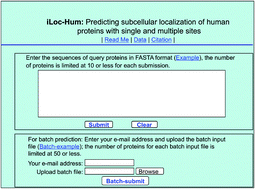iLoc-Hum: using the accumulation-label scale to predict subcellular locations of human proteins with both single and multiple sites†
Abstract
Although numerous efforts have been made for predicting the subcellular locations of

a
Gordon Life Science Institute, 13784 Torrey Del Mar Drive, San Diego, USA
E-mail:
kcchou@gordonlifescience.org
b
Computer Department, Jing-De-Zhen Ceramic Institute, Jing-De-Zhen 333046, China
E-mail:
xiaoxuan0326@yahoo.com.cn
Although numerous efforts have been made for predicting the subcellular locations of

 Please wait while we load your content...
Something went wrong. Try again?
Please wait while we load your content...
Something went wrong. Try again?
K. Chou, Z. Wu and X. Xiao, Mol. BioSyst., 2012, 8, 629 DOI: 10.1039/C1MB05420A
To request permission to reproduce material from this article, please go to the Copyright Clearance Center request page.
If you are an author contributing to an RSC publication, you do not need to request permission provided correct acknowledgement is given.
If you are the author of this article, you do not need to request permission to reproduce figures and diagrams provided correct acknowledgement is given. If you want to reproduce the whole article in a third-party publication (excluding your thesis/dissertation for which permission is not required) please go to the Copyright Clearance Center request page.
Read more about how to correctly acknowledge RSC content.
 Fetching data from CrossRef.
Fetching data from CrossRef.
This may take some time to load.
Loading related content
